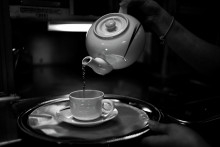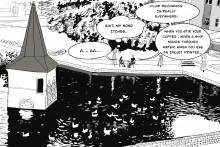It might not be a particularly existential question, but it is a phenomenon that mankind has had to deal with since it first invented pots and pans: the dripping teapot. Even our earliest ancestors knew that it is virtually impossible to pour tea or some other liquid without spilling a drop.
It took until the 1950s for the first scientific articles about the ‘teapot effect’ to appear, says UT professor Jacco Snoeijer of the Physics of Fluids department. ‘They were unable to find the answer, though. The scientists hardly considered the coating of the spout: is it water-repellent or not. However, that is where the answer largely lies.’
Snoeijer has been wondering about this for some time now. ‘Not every single day, of course, but still,’ he says. ‘The fact that I could not let go of this was due to a French research group, who demonstrated back in 2009 that you will spill a lot more when the spout is made of a material that the water can easily cling to. Unsurprisingly, two examples are glass and earthenware.’
However, a conclusive theory, one that can predict when and how much fluid will ‘stick,’ did not exist yet. ‘Colleagues at the University of Amsterdam were cleaning their tools,’ Snoeijer continues. ‘They noticed that the stream of water formed a helix around a needle and therefore slid down in a circular shape. At the same time, we were hard at work here in Twente to explore this phenomenon as well. Then it was simply a matter of combining our efforts.’
No teapots were used in the research. ‘We conducted our experiments with cylinders of different sizes, which we directed jets of water onto,’ Snoeijer explains. ‘The curvature of the cylinder is an excellent representation of a teapot’s spout.’ The result: when using a thin cylinder and a high-speed jet of water, the water will deflect somewhat, but nothing much will happen. ‘The thicker the cylinder and the lower the flow rate, the more the water curves around the cylinder. As a result, the water will flow down in a helix-shaped pattern.’
‘To get away from the surface of the cylinder, the water has to break free,’ Snoeijer continues. ‘The sharper the curvature, the easier the fluid will let go. That means there are a number of factors in play: sharp edges and a high flow rate. However, the material used also plays a part in the matter.’
Snoeijer does not expect this discovery to lead to no-spill teapots any time soon. ‘However, it also has other, more direct applications. One example is printing with ink, because you want all the ink to end up on the paper, instead of sticking to the print head. The same applies to the printing of fibres and plastics.’








